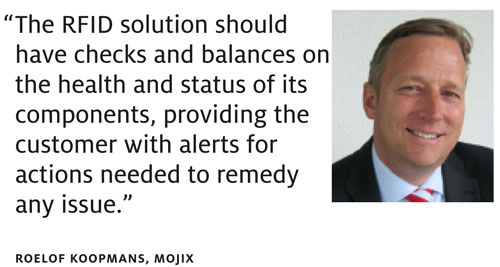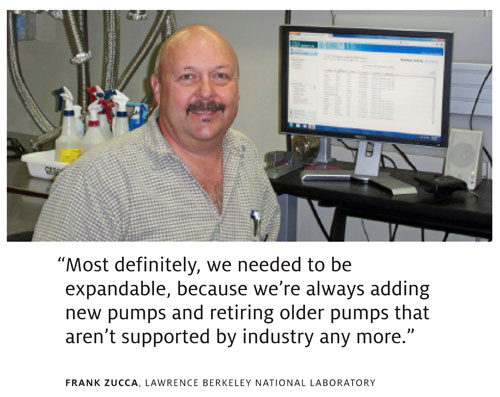Aug 01, 2012Obsolescence. You believe radio frequency identification will help your organization handle tasks more efficiently and cost-effectively, yet that word lingers in your mind. While the benefits of RFID have been proven, there's still some risk in investing thousands of dollars in a relatively new technology. You fret about deploying a system that may be made obsolete within a few years by evolving technologies or business practices.
This is a real concern, but not a reason to put off deploying an RFID solution that can deliver benefits today, say early adopters, technology providers and analysts. By applying some "futureproofing" strategies, just about any adopter can ensure its new system will function smoothly and productively for many years.
Futureproofing means taking a holistic approach to RFID design, implementation and maintenance. That involves determining your goals, analyzing systems from multiple angles, and understanding the relationships among hardware, software, standards, scalability, design and quality—all with an eye toward maximizing durability and longevity. Futureproofing also means keeping up with emerging trends—examining what's new while knowing what may be heading toward obsolescence—and creating strategies to deal with inevitable changes in technologies and business practices.
On the following pages, then, are seven strategies to futureproof your RFID system.
Futureproofed RFID systems are born on the drawing board. Careful and precise planning aimed at understanding current needs, predicting growth and determining how to integrate RFID with other existing and future systems is essential to ensure longevity.
"We want to get [customers] thinking about growth and future needs, and how their systems will accommodate these changes," says Steve Halliday, president of RFID consulting company High Tech Aid, in Gibsonia, Pa. "It really comes down to understanding where you are today and where you want to be in the future. Probably 75 percent of people can't tell you where they want to be—they only have some vague ideas."
When working with a customer to develop an application, Halliday says, his firm leads the client through a logical thought process by asking questions such as:
• How do you do this now?
• What information is missing?
• What makes your process difficult?
• Who does this work?
• What do you really want to make your life easier?
• Who/where is the bottleneck in your current system?
• How do you see the system working in two years? Five years? Ten years?
"From this, we try to create a plan for them for the implementation and for the future, so they have a path forward," Halliday says.

Strategic planning also can help early adopters manage risk. "In most cases, early adopters are the people who gain the most," says Chris Hood, Europe, Middle East and Africa channel sales manager for tag supplier Omni-ID, in Rochester, N.Y. "They get a march on their competitors." Yet, there's a reason brand-new technologies and approaches are often described as "bleeding-edge."
The key is to look for value in whatever product or service is being offered, and then measure potential opportunity against likely risk, says Michael Liard, RFID director at VDC Research, a technology market research and strategy firm in Natick, Mass. "You don't want to buy something with all the bells and whistles in the mistaken belief that it alone will provide a futureproofed solution," he says. "The best approach is to have a short-, mid- and long-term vision around RFID and what that will mean to your operations."
A business' initial move into RFID should be an effort to improve core business functions, such as inventory management and manufacturing processes. Core functions generally offer the richest return on investment opportunities. Only later, when a business can leverage the experience gained while applying RFID to core functions, should RFID be extended into other, less critical areas.
"Everything starts with processes," says Roelof Koopmans, managing director for Europe at Los Angeles-based RFID systems developer Mojix. "Our customers do very well by identifying key processes where they think they can gain efficiencies or quality improvements."
Deployments that improve core business functions begin generating operational and financial benefits almost immediately and will continue offering productive service for many years, Koopmans says. "We've seen that the customers who do their homework, they're getting the most out of these technologies because they know exactly where to enable processes with RFID technology."
Midwest Transit Equipment, a Kankakee, Ill., firm that specializes in commercial bus sales, is using Intermec RFID technology to track and manage its vehicle inventory. John M. Keigher, the company's director of systems and human resources, had his priorities in order before planning began on the bus inventory-management system. "For us, RFID improved our inventory and maintenance processes, which are the core parts of our business," he says. "We see the technology as a way to do things we could not have done with other technologies or our existing manual processes." System deployment has been completed at all four of the company's current bus inventory sites.
Unless you have a really good reason for doing something differently, design your system for compatibility with accepted standards. "We try to only supply systems that are based on standards," Halliday says. "We don't use proprietary stuff, because there's too much concern about whether it will still exist in two or five years."
At the technical level, there's already a large and well-established standards base. "By and large, particularly for passive UHF, we're in good shape when it comes to standards," Liard says. Many once-innovative RFID technologies are also being rapidly standardized. "We're starting to see some additional development away from proprietary solutions in the active RFID community—ultra-wideband is a good example—as well as for some of the 2.45 GHz solutions," he says.
Industry-specific standards are now available in many areas, from retailing to manufacturing. "[When] using data standards from ISO or EPC or whomever, we look hard to determine if there are already standards in their industry that [the customer] should be focusing on," Halliday says. "A company might be working in the health-care arena, for example, and have no idea that there are already standards that relate to what they're doing." Such standards include Health Level 7 specifications that define the interchange of data and the ISO/IEC 15408-1 IT system security standard.
Still, futureproof-minded adopters must select their standards wisely. Glyn Matthews, senior IT project manager for Speedy Services, a tool-rental company in Haydock, England, was concerned about standards when he began investigating RFID tool-tracking systems. Colleagues told Matthews that low-frequency RFID was a better, cheaper choice than ultrahigh-frequency. "When we started this project in 2010, there was a lot of skepticism in the RFID world about whether you could do tool tracking using UHF RFID tags," he says.
Matthews decided to find out for himself. "We were already using low-frequency tags in the rail division of our business," he says. "The technology was old, and the read range was not good enough for a walk-through portal. We wanted the tags to be inside [the assets]; we wanted them to be read without the customer having to do anything.
"I went to RFID Journal LIVE!, in Darmstadt, Germany," Matthews says, explaining he left the event convinced that UHF was the way forward. "It seemed LF tags were being phased out in a lot of places," he says. "That was one of our main reasons for going with UHF tags. It was very much about following the Gen 2 and GS1 [specifications]. I got quite a few contacts [at the event] and started contacting people to send me some tags." After studying and evaluating the products, he felt confident his gut instincts had been correct. "I had tags sent to me from all over the world, and the [UHF] Omni-ID tags were consistently giving us good reads inside an asset."
Making a commitment to using high-quality system components, including durable tags, sturdy readers and bug-free software, is one of the most important steps a business can take to keep its RFID system running trouble-free for many years.
"Quality hardware and software components are critical for futureproofing," Midwest Transit's Keigher says. "They allow you to have a durable, robust system that lasts for a full technology cycle."
Organizations that deploy RFID in rugged environments, such as places afflicted by extreme heat or cold, often benefit the most from quality RFID products. "We wanted something durable because nearly everything we do is outside in the weather," Keigher says. "We're in the Midwest—we've got snow and ice in the winter, and in the summer many days of over 100 degrees."
When used in industrial settings, particularly outdoors, poor-quality equipment is more susceptible to dust, bumps and drops. Keigher says his system needed to be resilient enough to resist all these conditions, so using quality components was essential. "We wanted something we would be sure was a long-lasting investment for us," he says.
Many RFID adopters with long-term goals focus on hardware technologies and specifications while neglecting software requirements. That can be a big mistake. "When futureproofing, you have to start thinking about the software capabilities," Liard says. "How are upgrades going to be handled? You've got to make sure that's done automatically and is part of the solution." Both system and application software need to keep pace with growing business needs and evolving technologies.
RFID hardware must also be able to accommodate new and enhanced types of software. "If there are any changes to application software, or different types of protocols that need to be pushed through to a reader device, you need to be able to do that through a firmware upgrade that's automatic," Liard says. "That will help you futureproof your RFID system from a technical perspective."
Adopters should be proactive in asking their hardware supplier—whether direct from a vendor or through a reseller or integrator—key questions around technology futureproofing and device upgrading via firmware, Liard adds. "Specifically," he says, "what are the associated costs, frequency of upgrades and features/functions that are upgradable?"
Some RFID systems meet a premature death because they can't keep up with growing operational demands. Careful scalability planning, performed at the project's start, can extend a system's service life by years, potentially decades.
"Scalability is important from day one—even if there is no current need, it has to be understood and discussed," Halliday says. "Unfortunately, it's real easy to design a system that can't be scaled—probably less expensive as well—because you're not looking at options for the future."
Failing to plan for future needs can lead to serious and expensive problems down the road, when managers and staff members find themselves struggling with a locked-in system that can't keep pace with increasing workflow demands.
Frank Zucca, a senior mechanical engineering technical associate in the Advanced Light Source (ALS) unit of the Lawrence Berkeley National Laboratory, says he took scalability into consideration when evaluating RFID systems to track and manage the equipment scientists and technicians use in the facility. In 2011, ALS deployed an active RFID solution from RF Code, with software from AssetPulse. "Most definitely, we needed to be expandable, because we're always adding new pumps and retiring older pumps that aren't supported by industry any more," he says. "There was a real need to be able to expand."
Keigher made sure scalability was an integral part of Midwest Transit's bus inventory-management system. "It's a very scalable solution, because we can add any number of devices, and the cloud-based application doesn't impact our existing IT infrastructure," he says. "Additionally, the IP30 handheld RFID reader from Intermec supports a range of Intermec mobile computers, and it allows us to add RFID to mobile computers that we may migrate to in the future."
If your RFID solution provider doesn't raise the issue of scalability, ask. Understanding scalability and how to best achieve it is crucial to creating a truly flexible and adaptable system. "I think the worst thing is when a customer thinks they've got something that's going to last forever, and the supplier has done nothing to help them understand that it has severe restrictions and it can't be scaled for the future," Halliday says. "What's been proposed has been proposed down to a price rather than up to a requirement."
A futureproofed RFID system will last many years, so spending several months testing and retesting before deployment is a small price to pay for long-term reliability and performance enhancements. ALS' Zucca opted to trial two separate systems while evaluating RFID-based equipment-management systems. "We developed a beta test: a passive system and an active system," he says. The trial showed that the active system delivered operational benefits that far outweighed the passive approach's lower cost.
Jörg Sandlöhken, research and standards manager for German supermarket chain Rewe Group, is a strong believer in getting everything right before proceeding with final deployment. In 2010, Rewe Group began tracking returnable transport items at its Buttenheim distribution center with Mojix's STAR System. Like many RFID adopters, Rewe tested its system architecture in a limited trial deployment before deciding to invest fully in the technology. "We first created a trial, spending just a little money to see how RFID might work for us," Sandlöhken says. "I think that researching your options and first doing something on your own is always the best way."
7. Maintain Your System
Futureproofing demands a commitment to RFID excellence that doesn't end on deployment day, Liard says. He notes that system maintenance, upgrade, enhancement and expansion projects all need to be made with an eye toward ensuring longevity and addressing anticipated needs. "Futureproofing is about maintaining your system: What do I need to do today, and what do I need to do tomorrow—just in case," he says.
It's essential to establish a maintenance schedule, since a poorly maintained system is likely to fail prematurely. "A customer or end user should feel very at ease once a vendor has completed work on deploying an RFID solution, and feel like the system should operate with very little maintenance," Mojix's Koopmans says. "The RFID solution should also have checks and balances on the health and status of its components, providing the customer with alerts for actions needed to remedy any issue."
"Nothing lasts forever," Liard says. "There are always going to be new developments, the next best 'XYZ' or the latest update to whatever product is out there. But if you already see the value proposition and you've got a solid ROI model, total cost of ownership is digestible and the use case is there for you, I wouldn't wait to deploy."
Keeping a steady eye on future plans and goals is admirable. But if you find yourself postponing RFID plans in the hope that something better will soon come along, there's a strong chance you'll miss out on available productivity, efficiency and cost-saving opportunities.
For Speedy Services, moving ahead with its tool-tracking system sooner rather than later led to immediate benefits. "We can see the utilization of the equipment, what's being used and what's not being used," Matthews says. "It makes the administration a lot simpler—there are cost savings for the customer. There's also a cost savings due to reduced losses by theft."







